Mixed media textile artist, Emily Porter, creates one of a kind artworks using a sewing machine and alcohol ink markers.>
But for Emily, an art educator and commissioned artist, her success was not easy to come by. Her personal evolution from crippling fear and anxiety to professional textile artist was arduous; it required her to step outside her comfort zone and embrace her own power – time and time again.
Despite a childhood blessed with sewing and crafting inspiration, her anxiety remained and Emily found comfort in tactile fabrics and soft fibres. She was overcome by an enormous pull to create art – a pull that was always stronger than depression, careers, relationships and starting a family.
But only when a friend told her she was capable of so much more than the small bags and nature sketches that she dabbled with, did ideas and images tumble from her – that same night – like a cloudburst after a drought.
As she moved on to larger pieces on canvas, she finally let go of the disciplines from the Bachelor of Fine Arts in Printmaking/Drawing she completed in Washington University, St Louis, ultimately mastering free motion embroidery. As her love of textiles grew, so did her desire to create. She started to teach, always learning to stay one step ahead of her students and, in turn, counsel them to confront their mental health anxieties, just as she had overcome her own.
Today, Emily is a professional textile artist and member of the Society for Embroidered Work. Her black thread pictures are increasingly coloured with alcohol ink markers and vibrant threads and her evolution knows no bounds.
In this interview, you will learn how free motion embroidery became an obsession, how she builds her surrealistic pictures from divine inspiration and digital sketches, and how her art has been affected by recent worldwide collective trauma.
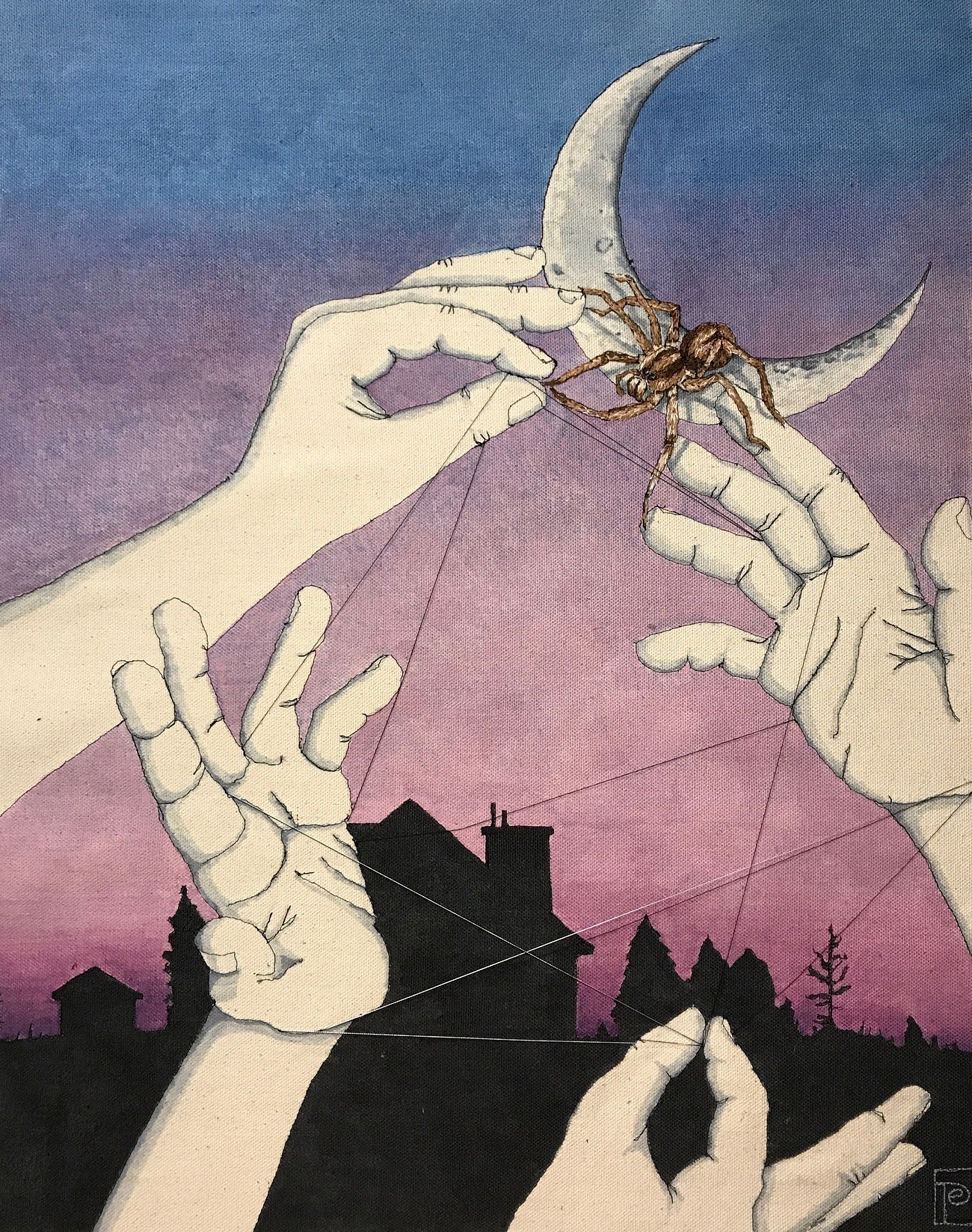
The solace of textiles
TextileArtist.org: What initially attracted you to textiles as a medium? How was your imagination captured?
Emily Porter: Ever since I was a little girl, I have been attracted to the coziness and calmness of fabrics and fibers. A smart, and subsequently worried and anxious child, I cuddled up to stuffed animals, flannel sheets, and fluffy sweaters to feel safe. When I learned how to weave in elementary school, I raced home to make my own homemade loom so I could recreate the magic. The coziness of the fibers, mixed with the repetitive motions, is a natural anti-anxiety for me.
My love for the sewing machine began at age 8 when my friend and I took sewing lessons from a neighbor. She taught us to make clothes and quilts and I was hooked. I begged my parents to take me to the fabric store so I could continue making quilts on my own (some that I still have!). I could sew happily for hours, hypnotized by the machine, while my friends grew restless for new activities.
Throughout the years, I have learned and played with so many fiber arts: weaving, knitting, crochet, hand embroidery, sewing, and free motion embroidery. These are the things I’ve turned to in my darkest times, feeling calmer with each stitch, letting the world fall away. Watching and feeling the threads and strands lock together is satisfying beyond measure. The results are cozy, yes, but also sturdy. Complete. Productive. Strong. The taut stress in each stitch, locked tight. Not easily unraveled.
As a printmaking major in college, textiles found their way into my work time and time again, sometimes eclipsing the printmaking medium altogether. My minor in Women and Gender Studies amplified my fascination with textiles by learning about the history of “women’s work”, the erasure of women artists from history, and the devaluing of the medium as a whole. My subject matter was and still is influenced by female empowerment and disempowerment. As a contrast, the printmaking world struck me as very much a boys’ club. But it was a cool club, and I wanted in.
As an adult, I tinkered and toyed, trying to marry the two media, feeling guilty about abandoning the printmaker identity. Eventually, my love for the textile medium won out, with me realizing that my work with textiles was stronger, flowed easier, and just as valid alone. Becoming involved with the beautiful textile and fiber community has helped to reshape my identity as a textile artist and I am constantly and continually inspired by the work I see from my peers.
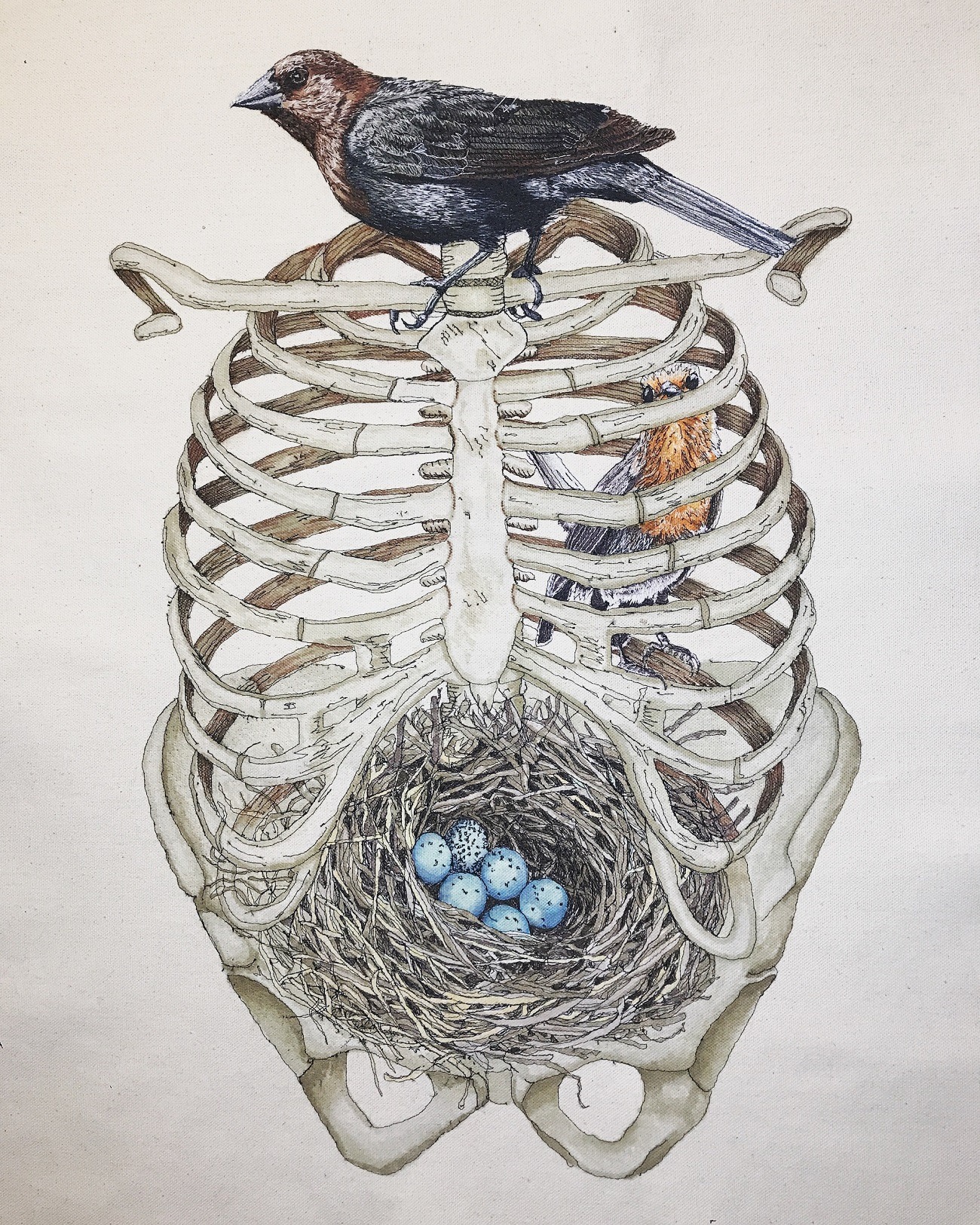
What or who were your early influences and how has your life/upbringing influenced your work?
My earliest influences were the older women in my life who also loved and valued art. Art teachers, neighbors, friends and family introduced me to all things art, encouraging me, telling me to keep going, and shining a light on my potential.
I am extremely fortunate and grew up privileged enough to have a wonderful art education and parents who recognized and encouraged my love affair with art. Our life was full of vacations across the country, seeing art museums and cultural sites. They encouraged me to pursue art school and sent me to study art abroad in Italy. Even when hard times forced me back into their house as an adult, they always made sure I had a place to create.
As wonderful as my parents are, they are also human beings. As much as there was love and support in my household growing up, there was also anger, high expectations, perfection, and anxiety. This led me to seek out art as a refuge and escape from my crippling anxiety and fear. My life outside the home was typical for many young girls: bullying, sexual harassment, a sense of feeling unsafe in one’s own body, a desire to reclaim your own power.
Doodling in class was the only thing that saved me from my daily panic attacks. Art became my safe space both in and out of school. That safe space was threatened by the pressures of art school when I got to college. The competition and critiques, the daunting talk of the “art world” chilled my love for art and the safety that I felt. After graduating in 2006, I did not create anything for years. I was overcome with self-doubt, fear, and was unable to find my voice. I turned to drugs and alcohol instead of art.
Ultimately, I realized that the depression and anxiety were so much worse when I created nothing at all. So art called me back, and I persisted, and I continued to create. Meek and small at first, a whisper. Small nature studies here and there. One day a few years ago, a dear and very blunt friend announced that I was capable of so much more – that I had more to say. That night, ideas and images tumbled out including one of the best and more personal pieces I created in my adult life.
My mental health healing journey and my art journey are now one and the same. The more I heal, the more I am able to create and put my art into the world. The stronger my voice and intuition gets, the more aware I am that it is a voice that others want and need to hear, so that they can feel connected and understood too. I feel passionate about helping people connect to their inner divine femininity, regardless of their gender, and showing the ways that we are all connected with one another and the worlds we inhabit. The sewn threads in my work represent this interconnectedness and the texture and comfort it adds to our lives.
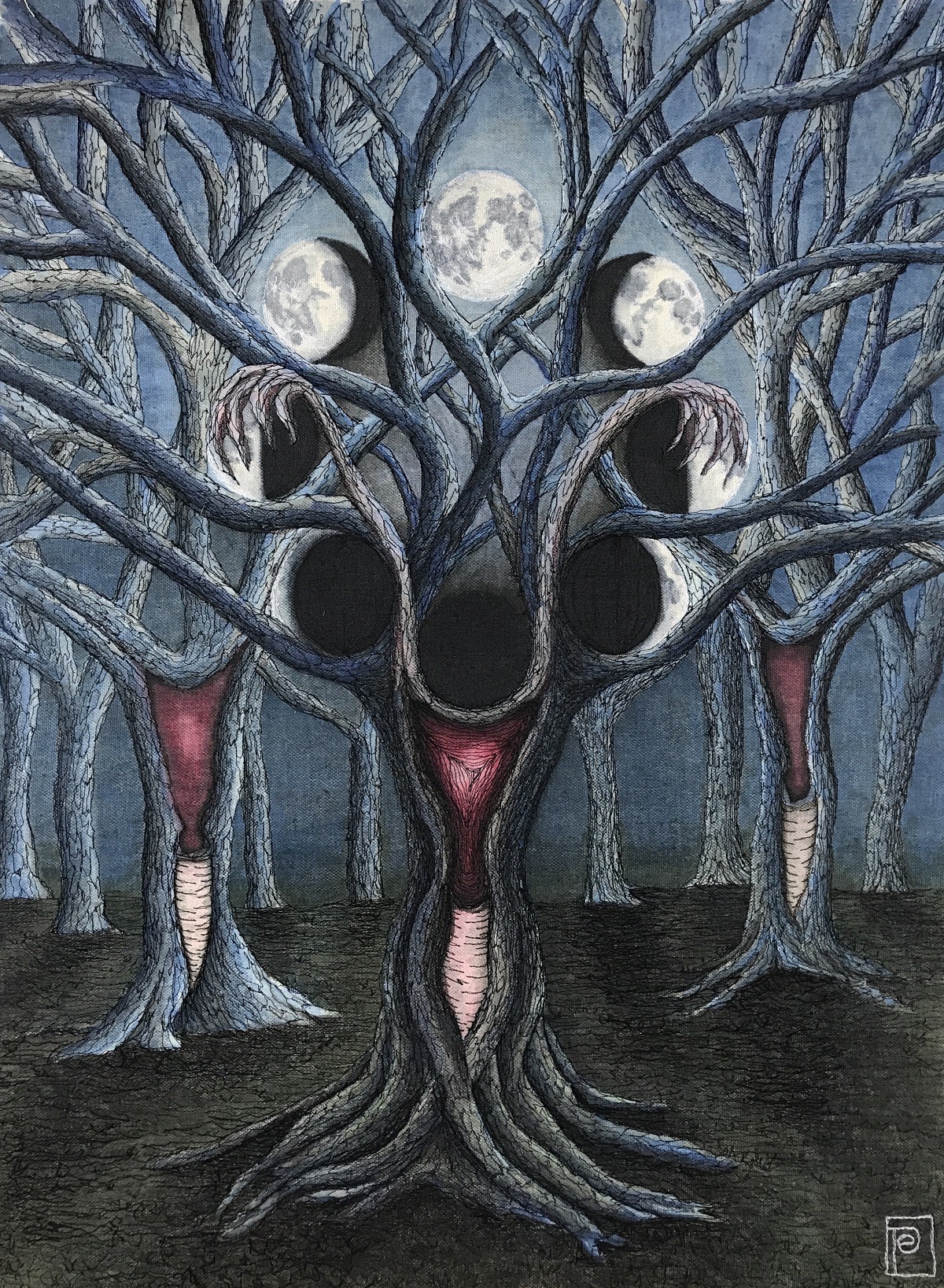
What was your route to becoming an artist?
I’m sure many people can relate to this but there are times when I feel like I’ve always been an artist, and times when I feel like I’m STILL not.
There have been many times in my life post-college where I was given a choice between art and something else – art always got her way. I chose art over other careers, I chose art over depression, I chose art over relationships, I chose art over starting a family. The pull to create is incredibly strong and in many ways it feels like there is not a route to become an artist, so much as you just are.
I often still think of myself as an art teacher rather than an artist. It is a constant battle to balance my career as an art educator with my work as an artist. My heart is often pulled in two directions. But, my work as an art educator has made me an infinitely better artist. Not only have I re-taught myself the basics in order to teach them to others, but the social/emotional work I do with my students to break their fear of art has forced me to take my own advice. I work at an online public school and our student population deals with a lot of mental health issues. I cannot help them confront their fears if I do not confront my own.
The pressures of working towards a professional art career have forced me to work on developing confidence and determination, overcoming perfectionism, and facing fear of rejection. I still have a long way to go and have only recently started to develop my career as a working artist, but I am enjoying the journey and all that I have to learn.
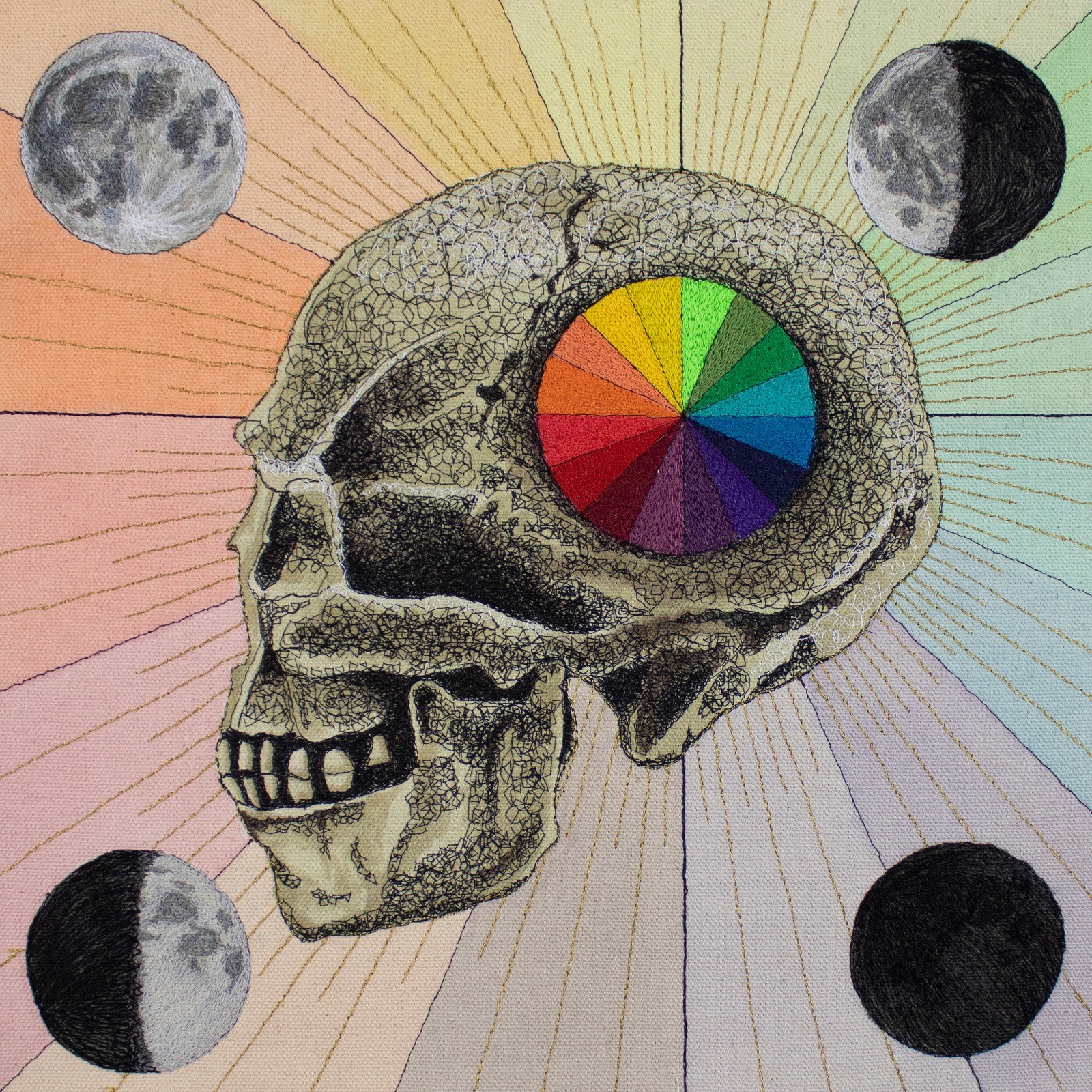
Imperfect, quirky, bouncy stitch
Tell us about your process from conception to creation
The majority of the ideas for my pieces come to me as a flash in my mind. I will be walking, or listening to music, or reading, and something seems to click in my brain and I get a vision of an image in my mind’s eye. I rarely know the meaning of the images right away, but I get to know them deeply as I work on them for hours and hours.
I make sure to write down or quickly sketch an idea before it flies away. Sometimes I will work on the actual piece right away, but other times, the idea sits for years before it’s brought to life. Once the idea and I are both ready, I use the procreate app to create a digital sketch, easily playing with colors and composition.
From there, I decide on a size for my canvas. I use unstretched, unprimed cotton canvas for most of my pieces. I sketch out my idea on the cloth using heat erasable pens. I used to sew on paper, but the more I explored free motion embroidery, the heavier I wanted to sew, and canvas is just a more forgiving surface for a needle and thread.
I outline most of the piece in thin black thread using free motion embroidery. This helps me to see my drawing and not accidentally iron it out, but it also gives it a very graphic, almost tattoo look that I really like. The next step is adding a base level of color using Copic markers. I have absolutely fallen in love with Copics. I used to use watercolor paint and was constantly frustrated with saturation and wet fabric issues. A friend in the textile community was using markers for some of her backgrounds and I borrowed the idea and ran with it. It completely transformed my work.
The next step of the process is to add detail and texture using more black thread, and more recently, lots of colored thread as well. This is when the pieces really come to life. I usually go back and forth a few times more between the markers and the free motion embroidery until there is a perfect balance. On a lot of the pieces, I find myself experimenting with loose threads on top of the piece. The last step in the process involves sewing a zig-zag stitch all around the edges of the pieces and cutting off any excess fabric. Oh, and I can’t forget the signing of them using thread, which I usually do forget!
I love to document and share my works in progress on Instagram. I get a lot of feedback from people about things that the piece reminds them of, which in turn gives me a better understanding of why the images came to me in the first place. I really start to understand the meaning they have in my own life and the meanings they have for others too. It is one of my favorite parts of the process. Knowing one’s art is meaningful to others makes the long hours of solitary work in my studio worth it.
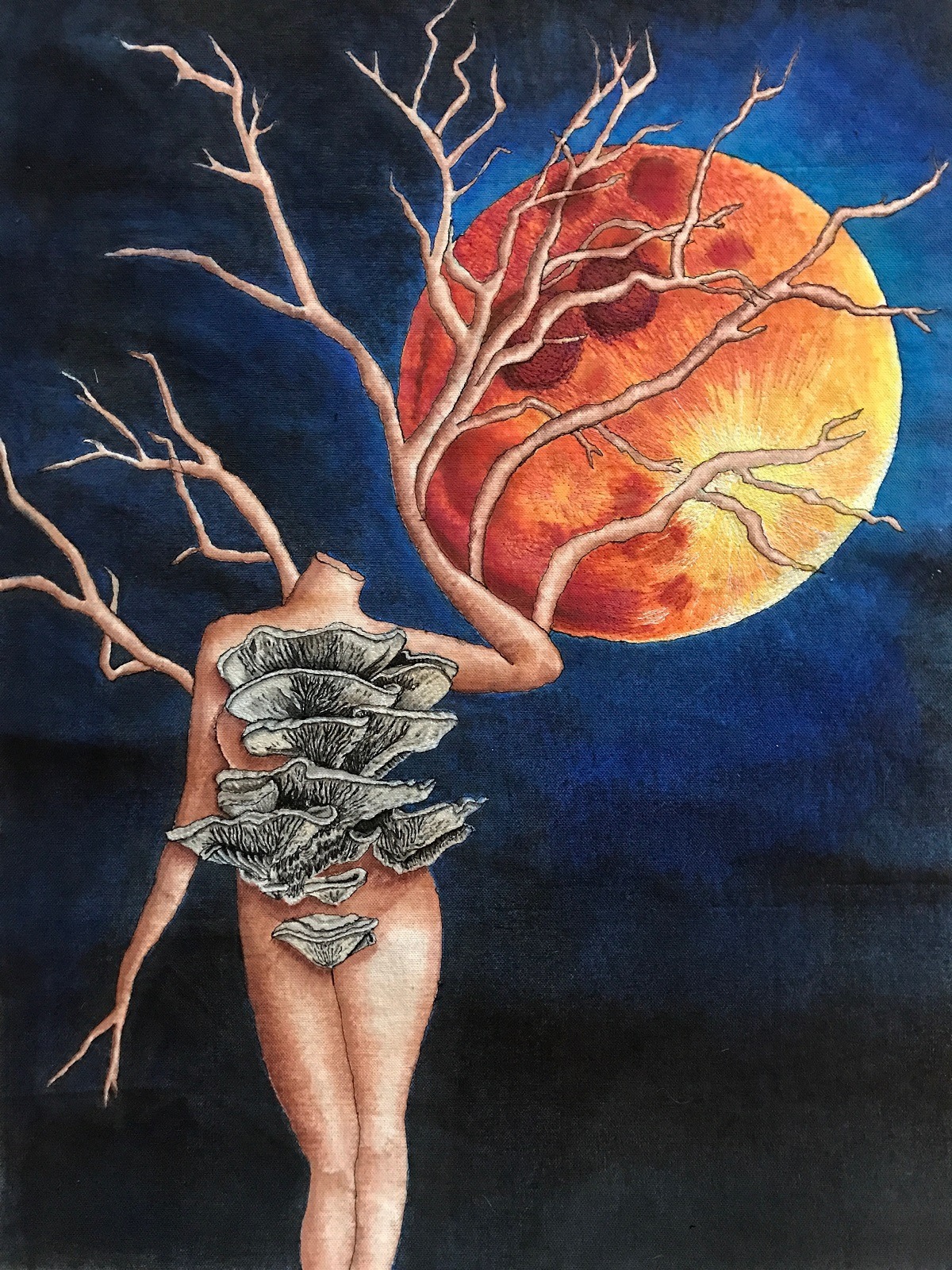
Tell us a bit about your chosen techniques and how you use them
I cannot remember how or why I came across free motion embroidery, but it was in my late 20’s and I have been obsessed with it ever since. It is imperfect, quirky, bouncy, and impractical and I will choose it again and again. Texture is one of my favorite elements in a work of art and free motion embroidery provides both visual and tactile texture. It feels permanent, substantial, handmade and cozy. Strong and soft. I’ve always loved sewing but absolutely hate patterns and measuring so when I realized I could sew with reckless abandon by using free motion techniques it felt like freedom. I’ve done hand embroidery as well but it never captured me quite like free motion does.
The introduction of alcohol ink markers into my work has enabled me to create in a way that I never have before. I can express myself with color in ways that I was never able to before. The rich and vivid ink doesn’t allow me to hide behind whispers of watercolor anymore. The amount of color choices and their consistency helps me to create a solid foundation upon which to add stitch, and a road map for shading and form. The only problem is my addiction to buying them and my ever growing collection!
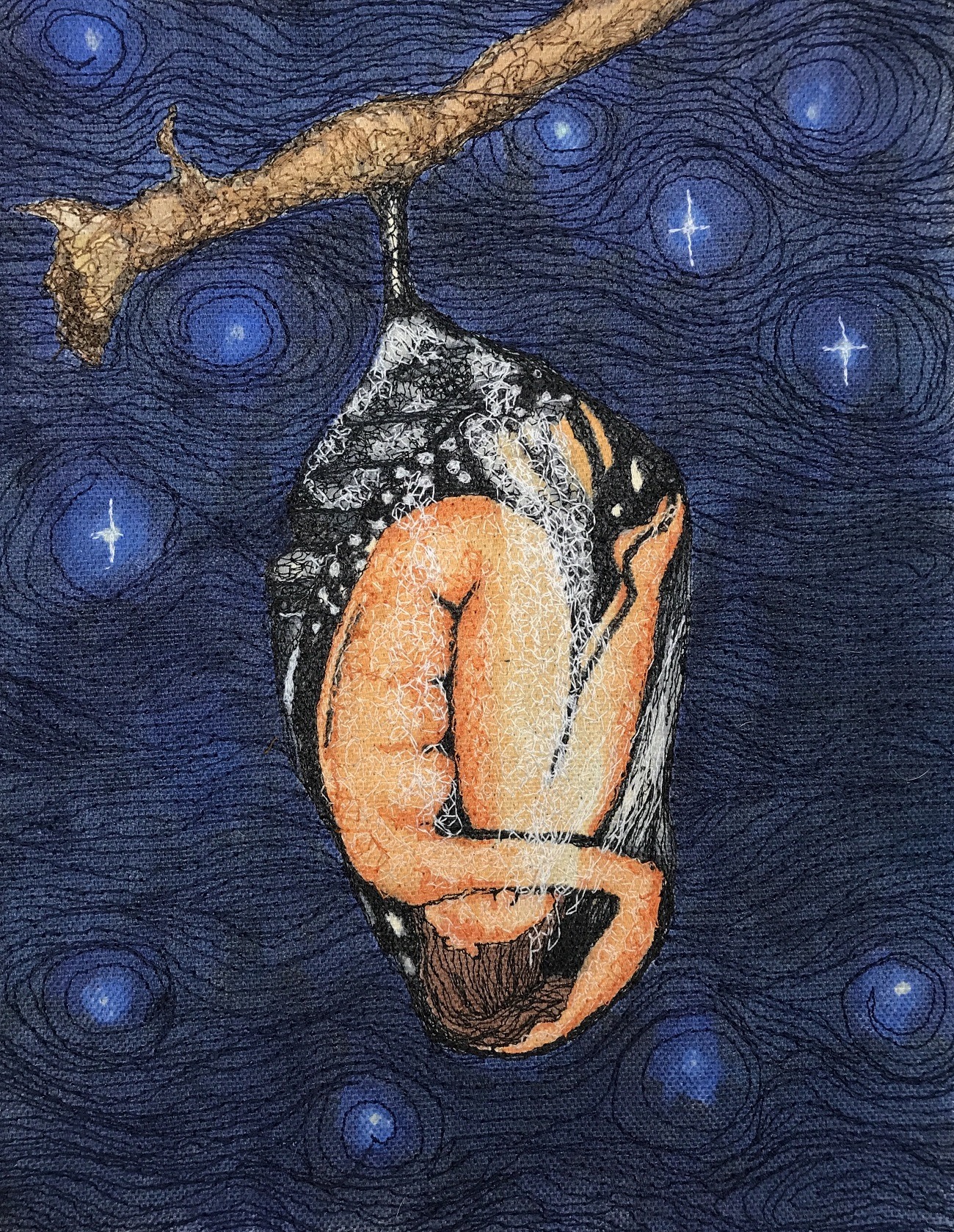
What currently inspires you?
I think the main theme running through all of my work is power. We all struggle with the push and pull of power. The devastation of feeling like your power is being taken away. The difficulty of trying to find and grasp the power we all have within ourselves. The kind of power that no one can take away, but that is so hard to hold onto ourselves.
I am inspired by all of the things we can turn to that makes it easier to find that power. From female friendships to connections to the divine feminine, the collective unconscious, and our mother earth. These things are all connected to one another and are the key to our psychological well being. We already have all the answers, our path is finding them. My goal is to find them, understand them, and make beautiful reminders for others.
At the moment, we are going through a collective trauma. I am inspired by the effects of isolation and loss on the human psyche. I am exploring the feelings of being trapped, of life standing still, and of transformation. I think in metaphors, patterns, and cycles and this is a rich topic for exploration both on a personal and collective level.
Stylistically, I am very influenced by pen and ink artists, tattoo artists, and Japanese printmakers. I am also in love with surrealism, especially the female surrealists. I’m inspired by any and all wild women, the difficult, nasty, and unapologetic women.
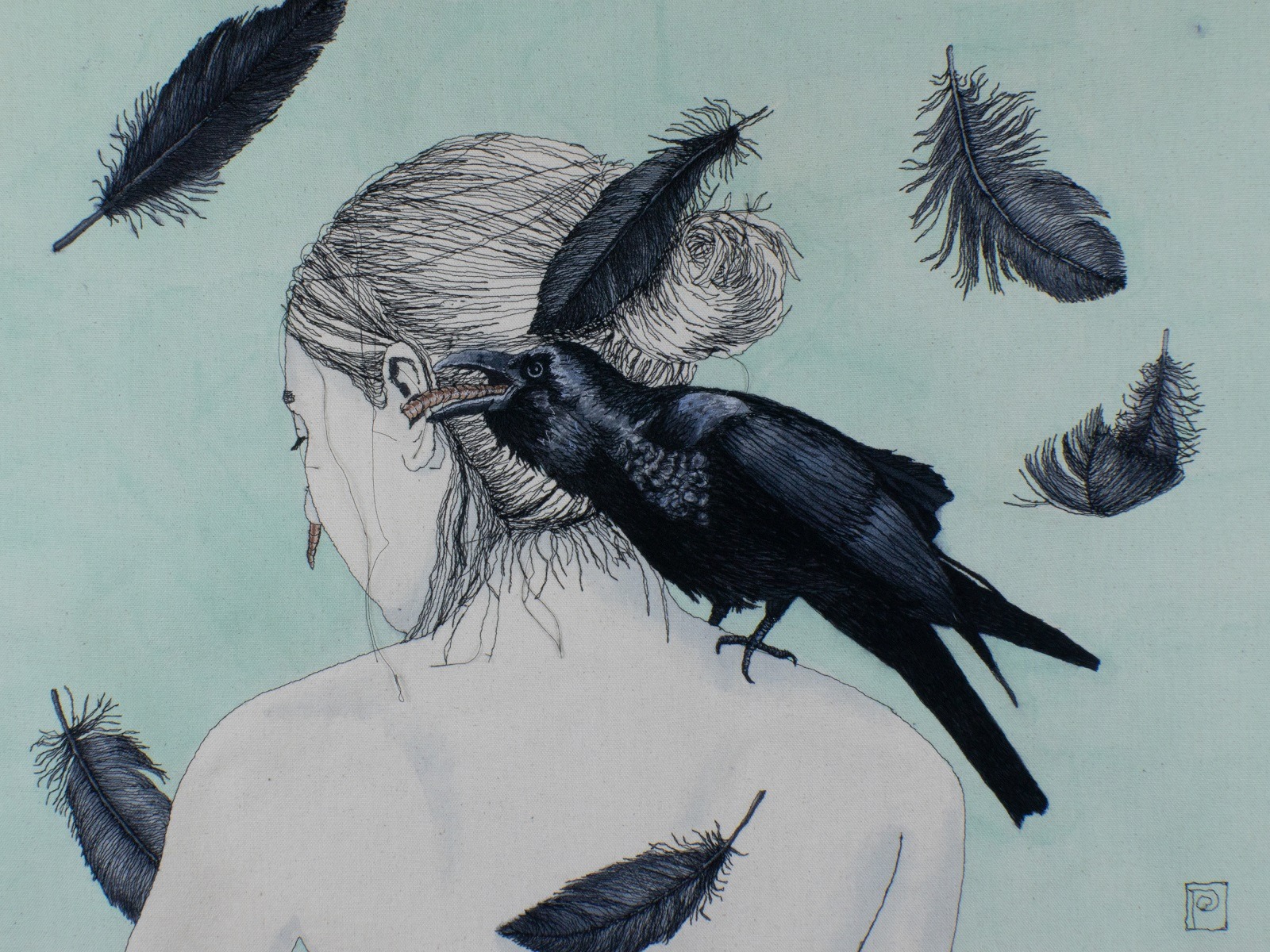
Expansive growth
Tell us about a piece of your work that holds particularly fond memories and why?
After my lovely friend reminded me how much more potential there was for my work, one of the first ideas that came to mind was the image in the piece Wormhole. It is very much a self portrait of my inner critic weighing me down and worming its way into my every thought. I sketched out the idea in a notebook that night but the sketch stayed waiting in my sketchbook for years.
Once I had started creating large works on canvas, and after discovering the joy of Copic markers, I knew it was time to bring the piece to life. I have especially fond memories of making the piece because I really went outside my comfort zone and tried some things that felt daring to me at the time. I made some mistakes and just kept working. I didn’t let that inner critic dictate my behavior.
The greatest memory from that piece is how much it resonated with others. It is not only my favorite piece that I’ve created but many others as well. The piece sold almost immediately and the owner has her own, very deep connection to the imagery. I feel like the journey of the piece is complete and that sense of completion is very comforting.
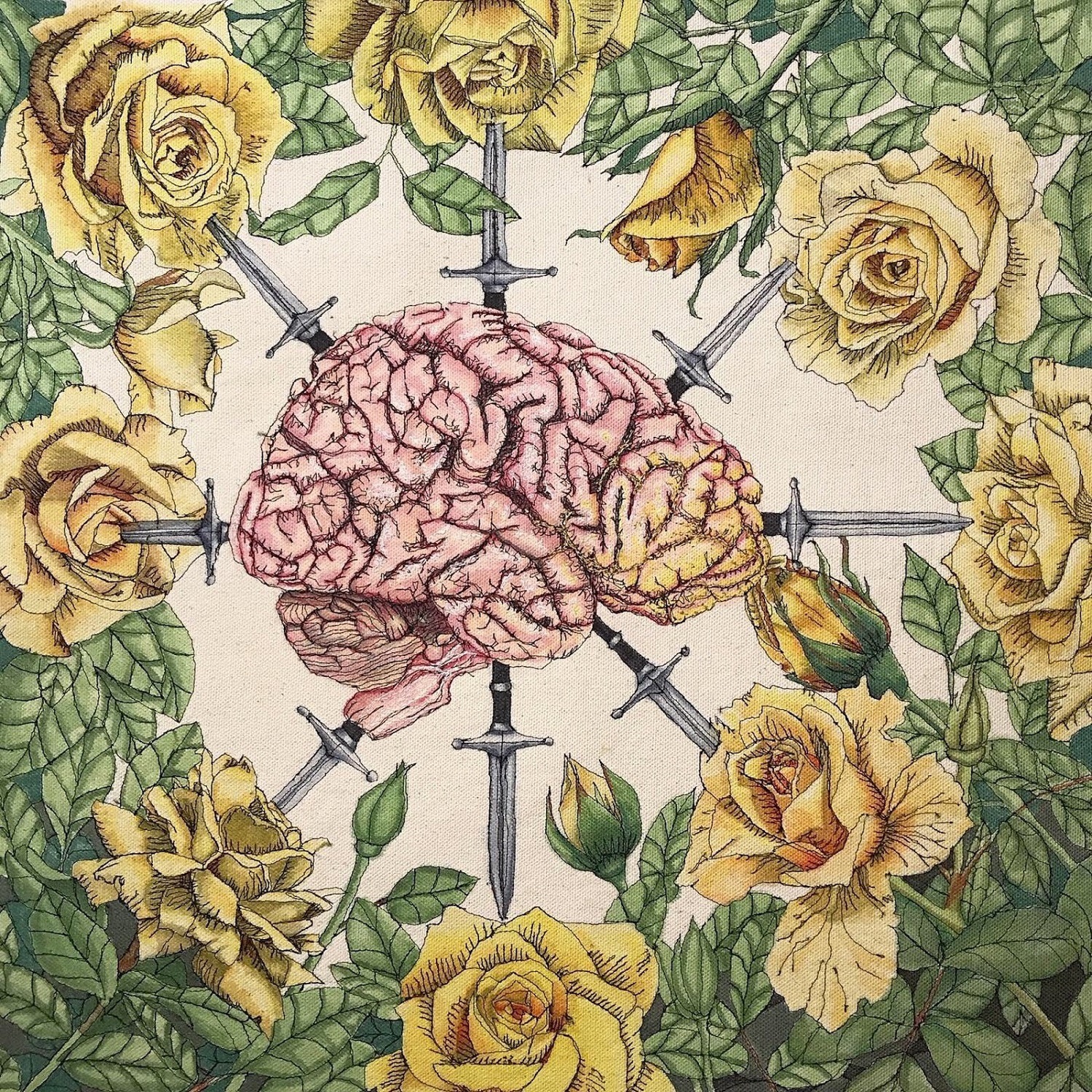
How has your work developed since you began and how do you see it evolving in the future?
My journey with free motion embroidery began with more of a craft focus. I started by making small decorative bags and slowly worked my way up to small studies of nature on paper, followed by much larger pieces on canvas. Each iteration of my work came from a desire to do more. More sewing, more detail, more meaning, more storytelling. Every time I wanted to tackle a more complex idea or technique, I needed to level up. I needed to experiment with new techniques, work larger, and push myself outside of my comfort zone.
There is definitely a correlation between how much I am learning about myself and healing to the level I am able to achieve in my work. I am excited to see where my work will evolve in the future. I am definitely focused on improving certain aspects of my work like my ability to capture the human figure, and creating more complex, dynamic compositions with layered space and movement. I am keen to keep experimenting with new materials and possibly 3D work. I love that there is still so much more to learn. I also aim to make work in series, although I find it difficult to do.
I would also like to focus more on getting my work in front of others. The current pandemic poses a very real challenge to artists in getting their work in front of the general public, but I’m excited to learn from others and to possibly think of innovative ways to share our work.
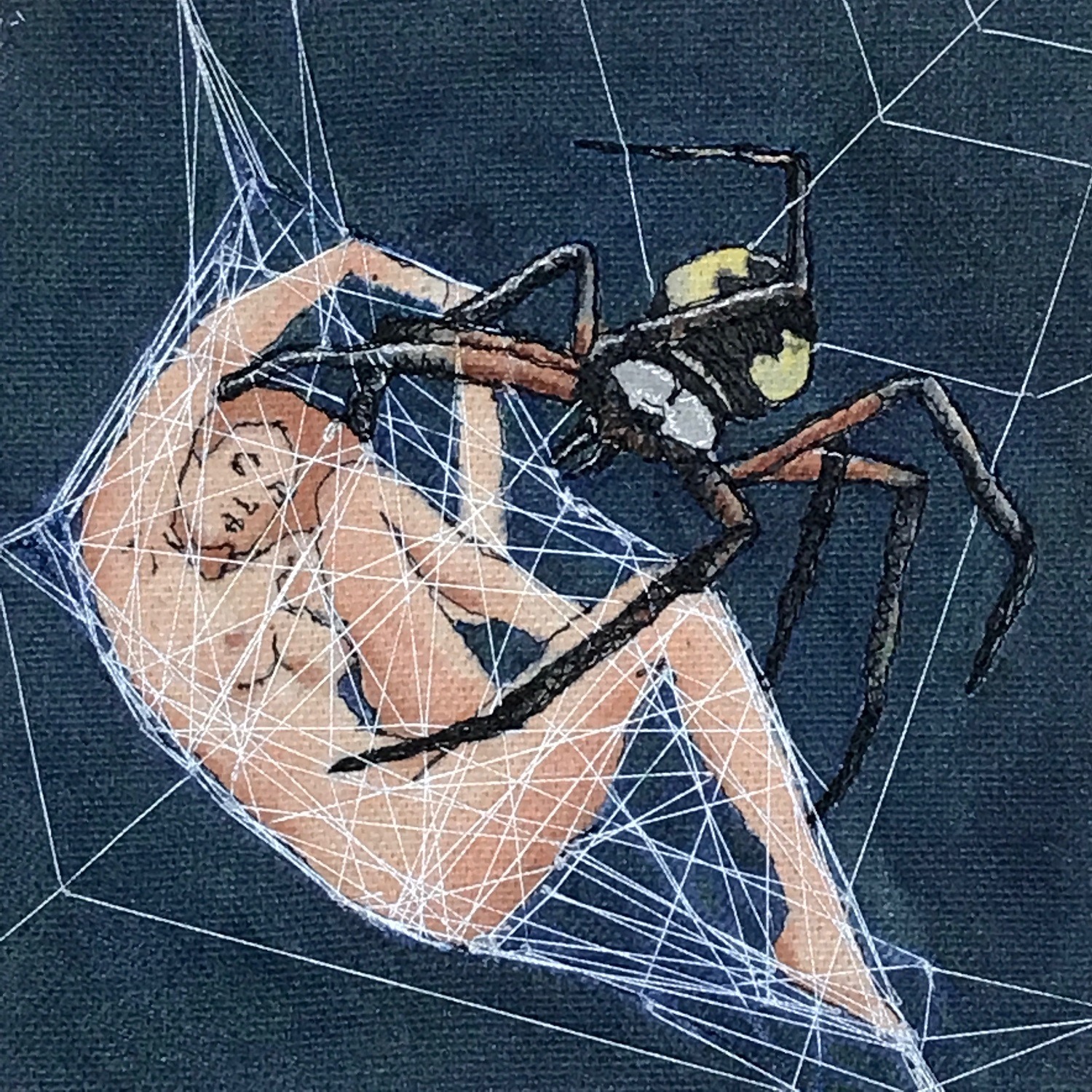
What advice would you give to an aspiring textile artist?
PLAY. My advice to an aspiring textile artist would be to play and experiment. Find the techniques and the styles that you love. There is no one way to make textile art, so give yourself the time and freedom to play around and figure it out. Make a hundred terrible things so you can make one thing you like.
DON’T LISTEN TO YOUR INNER CRITIC (or any other critics). Try to avoid perfectionist thinking or comparing yourself to others. This is the biggest single mistake I see my students making. Try to have a growth mindset and you will be amazed at how much you can grow if you don’t listen to the little negative nagging voice in your head and let yourself create anyway. If you’re overwhelmed, just try to set aside a little bit of time every day to work – it will add up!
SHOW YOUR WORK TO OTHERS. Don’t be afraid of rejection or putting yourself out there. Don’t let your work sit in the dark. It will help you grow. Make friends in the textile/fiber community. My Instagram feed is such a supportive and inspiring place full of textile artists from around the world who have helped guide me and cheer me on. I am constantly inspired by the artists who have been working longer than myself and are a few steps ahead. I’m equally inspired by watching younger artists grow and develop on their journey.
HAVE FUN. My biggest piece of advice is to have fun. Use your supplies, even if you feel like you’re wasting them. Make a mess and leave it there. Fail and then fail again. Don’t lose sight of why you make art, which I’m guessing is just because you really love it. So enjoy yourself.
For more information visit www.emilyporterart.com and Instagram
Has Emily’s story inspired you to try something new? We’d love to know in the comments below.
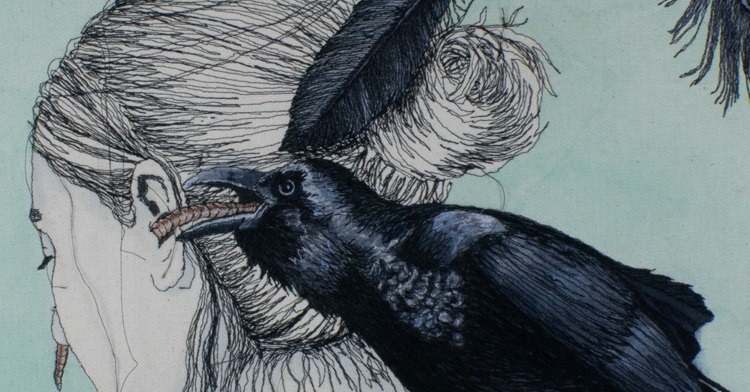

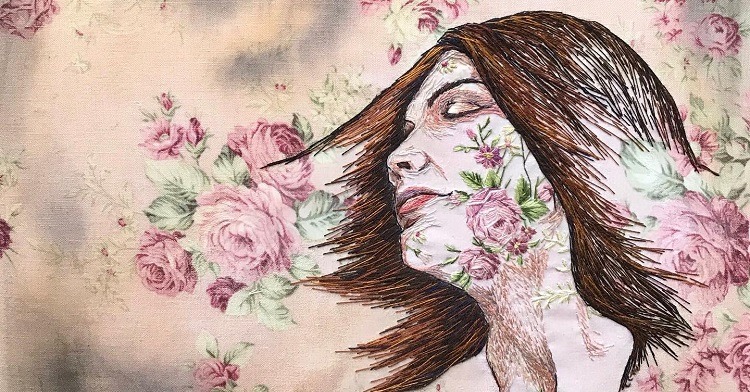
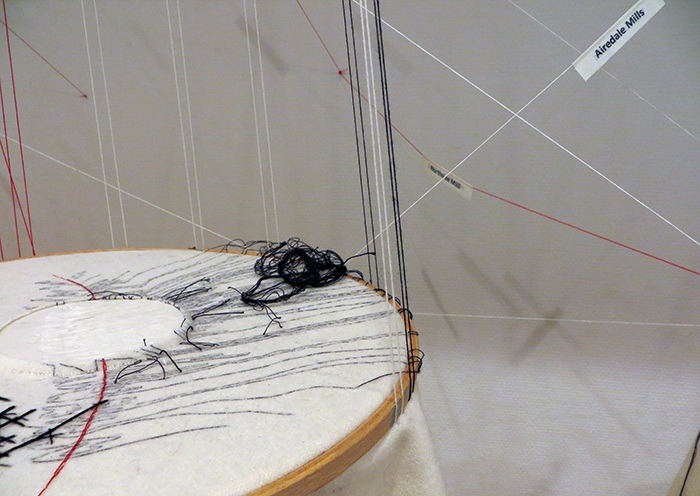
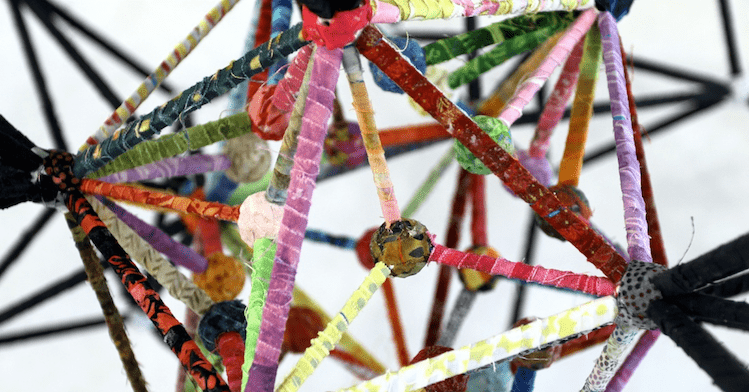
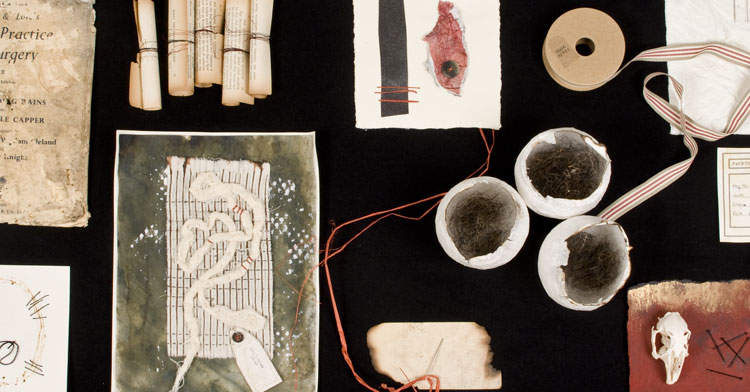
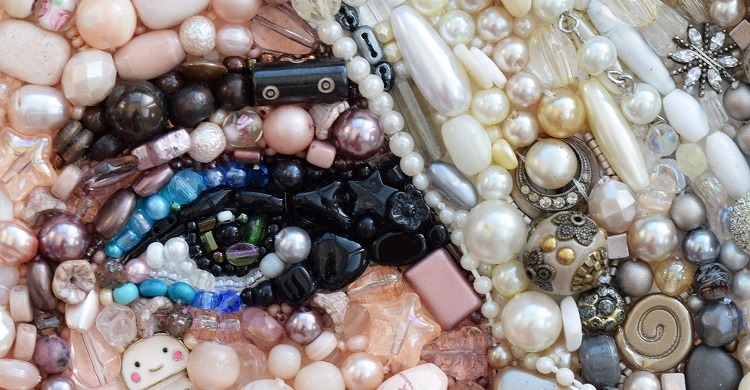
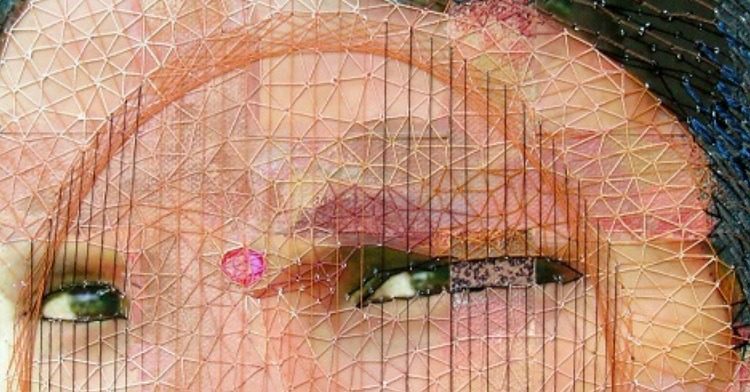
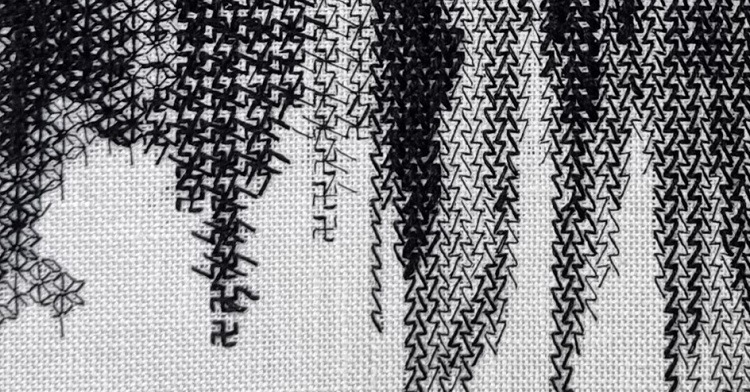
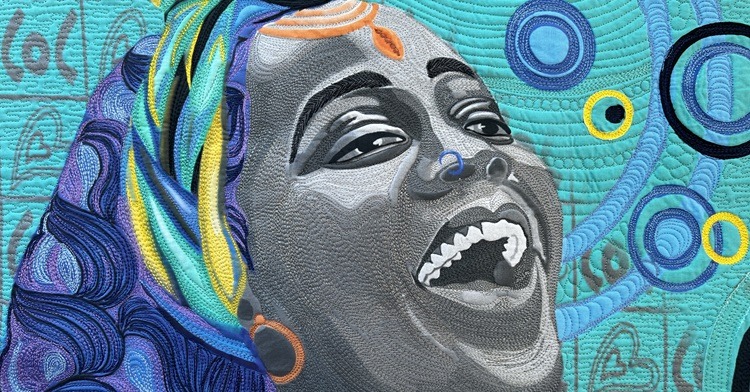
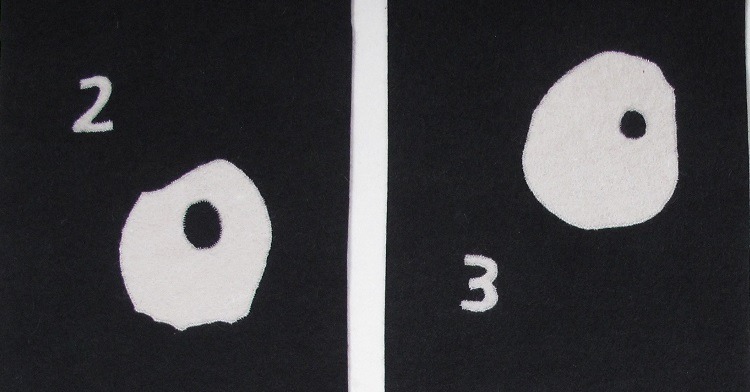
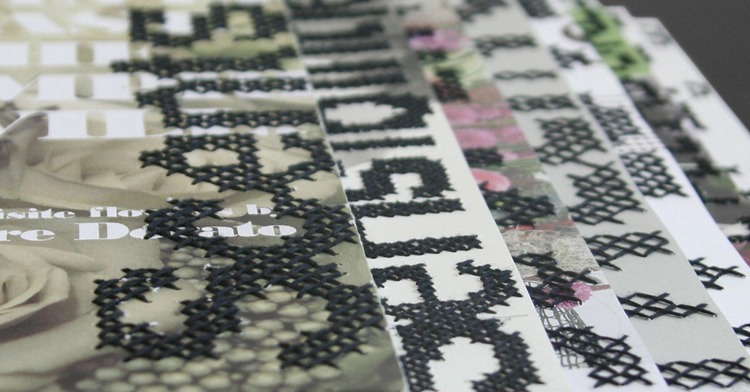
6 comments
Eithne
I’m off to play and have fun while not listening to my inner critic!
Emma
This resonates hugely with me. I can feel I am at the beginning of a similar path and will take the advice on board and hopefully run with it. Thank you Emily for sharing your story.
Karin
I really enjoyed reading your all inspiring article on your journey as an artist. I think we all suffer from , doubt and negative thoughts on our own journeys !!! Love your work. Well done.
Chris
Brilliant, such an inspiring interview. Thanks.
Barbara
Thank you for sharing your story, many times we see beautiful art and don’t realize the process the artist endured to reach that point. Your art is thought provoking and a joy to see.
Jennifer Williams
This post is so inspiring, I’m keen to try both techniques.J